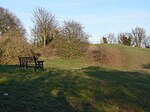Jenny Hurn
Landforms of LincolnshireRiver Trent

The Jenny Hurn is a bend on the River Trent in Lincolnshire, England. It is a tight bend on the navigable stretch of the river and historically has been a dangerous spot; orders were made to prevent boats from waiting there. It is now the site of a pumping station to drain nearby farmland and an air quality monitoring site. In folklore, the site was the haunt of a boggart known as Jenny who crossed the river in a pie dish to feed on crops in nearby farmland.
Excerpt from the Wikipedia article Jenny Hurn (License: CC BY-SA 3.0, Authors, Images).Jenny Hurn
East Ferry Road, West Lindsey Wildsworth CP
Geographical coordinates (GPS) Address Nearby Places Show on map
Geographical coordinates (GPS)
| Latitude | Longitude |
|---|---|
| N 53.4785 ° | E -0.7727 ° |
Address
East Ferry Road
East Ferry Road
DN21 3DY West Lindsey, Wildsworth CP
England, United Kingdom
Open on Google Maps










